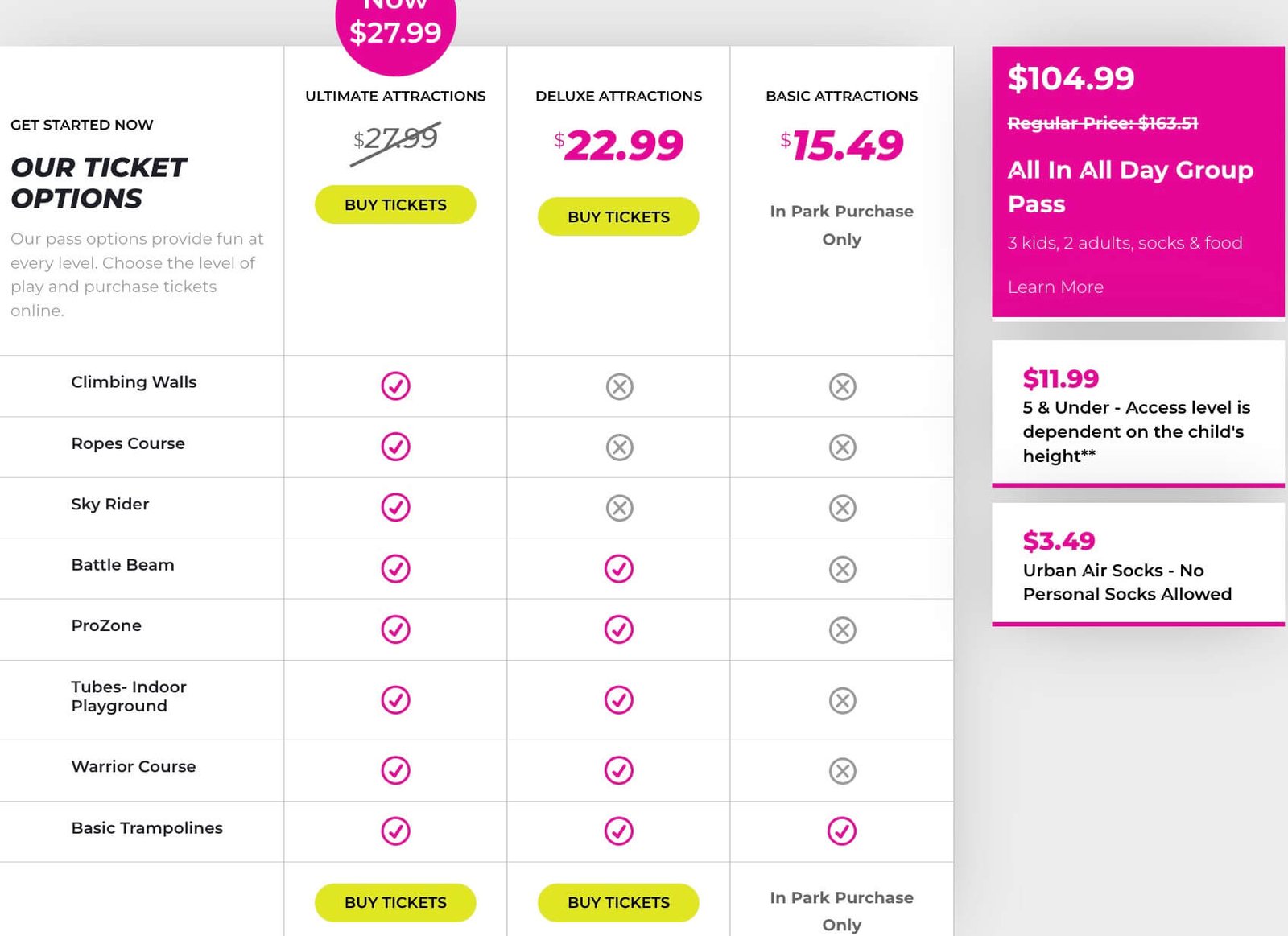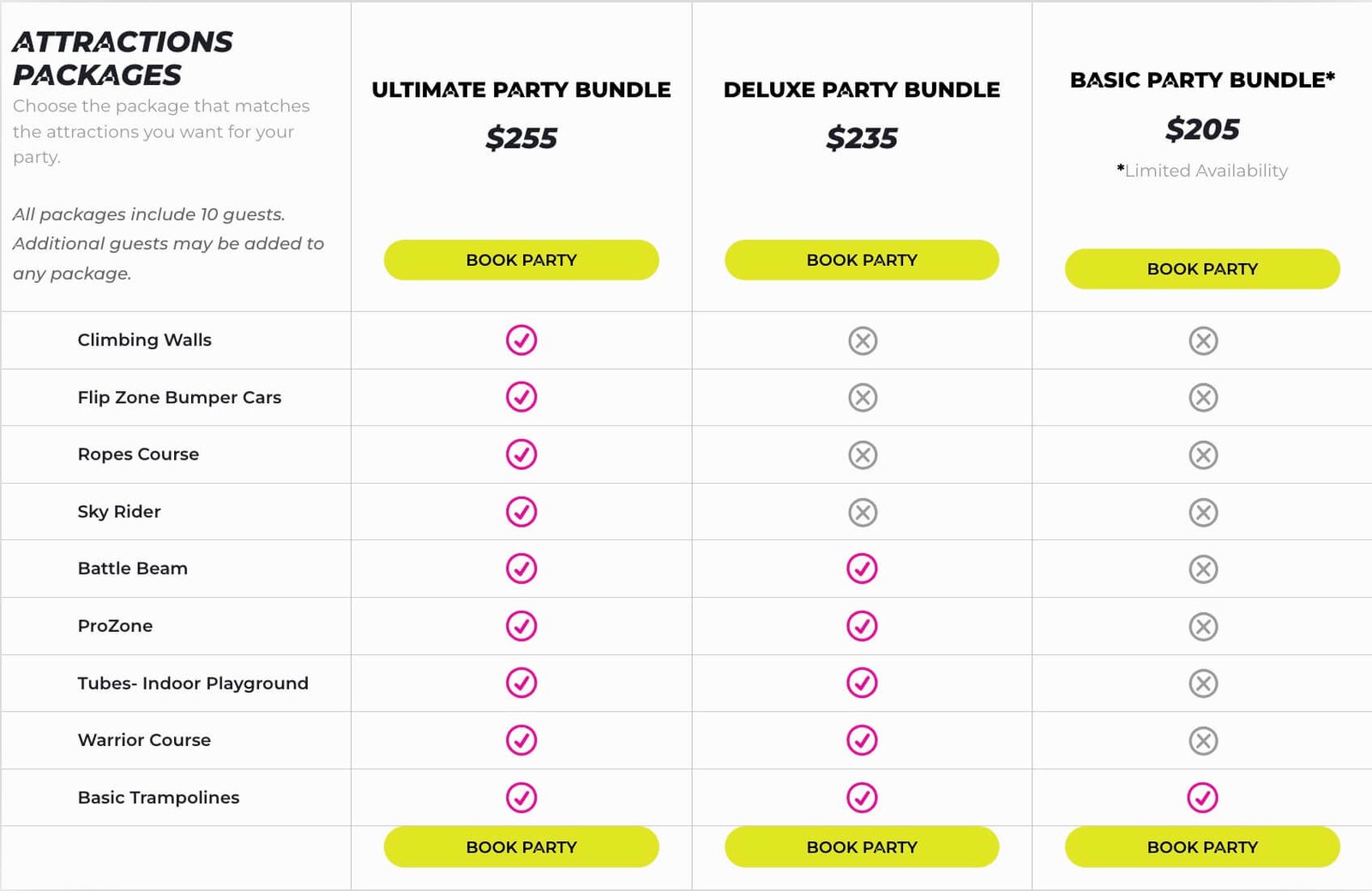As an indoor trampoline park operator, you probably constantly asking yourself one critical question: how can you maximize profits while keeping your business running smoothly? The challenge is finding the balance between safety, the customer experience, and making money. But here’s the real problem: if you don’t understand how to maximize your revenue streams, you could struggle to keep up with the competition in a crowded marketplace. The good news is that trampoline parks have many ways to make money, but how do you take advantage of them? In this post, I’m going to break down the primary ways indoor trampoline parks make money and how you can maximize each one.
Indoor trampoline parks make money in a variety of ways. Their primary revenue streams include jump tickets, party packages, food and beverage sales, special events and competitions, memberships and season passes, and merchandise sales. This variety allows trampoline parks to attract a wide range of customers—from families looking for something fun to do on the weekend to businesses looking for a cool place to host team-building events. When you manage these revenue streams well, they help you maintain healthy profit margins, even with high operational costs and competition.
The Primary Revenue Channels
Admission Fees
The main way trampoline parks make money is through admission fees. People pay to get into the park and then they can jump on the trampolines, play in the foam pits, and run through the obstacle courses. Prices can vary based on age, how long you’re there, and if they’re having any special events. They have all kinds of options to make sure that everybody can get in and have a good time.

Party Packages
Another big moneymaker is hosting birthday parties and group events. Trampoline parks are a popular destination for kids’ birthday parties, and most parks offer customizable birthday party packages that include food and drinks, a dedicated party area, and access to the trampoline courts. These packages are priced at a premium, and you can make even more money by upselling additional services like extra jump time or exclusive party areas.

Food and Beverage Sales
Most trampoline parks have a snack bar or café on-site where guests can buy food, drinks, and snacks. This is a convenient option for parents who might want to relax with a coffee or for kids who need a quick snack after jumping all over the place. By marking up food and drinks, parks can significantly increase their profit margins.
Special Events and Competitions
Trampoline parks will often host themed events, competitions, or tournaments to get people to come back. They might do things like dodgeball tournaments, ninja warrior competitions, or even trampoline-based fitness challenges. These are additional revenue streams, and they get people to come back with friends and family. You can charge for tickets, and you can charge an entry fee to participate. It’s also a way to build a community around your park.
Membership and Season Passes
If you have families or individuals who want to come to the park all the time, you can sell them a membership or a season pass. They pay a flat fee for unlimited or discounted visits over a set period, which encourages repeat visits and ensures steady cash flow for the park. While the upfront payment for a membership is less than individual visits, the long-term financial stability and customer loyalty these passes create are invaluable.
Merchandise Sales
Branded merchandise, like T-shirts, socks, water bottles, and other accessories, is another way to make additional money. People, especially kids and teenagers, love to buy stuff with your logo on it when they come to your park. It’s also free advertising for your park because they’re going to wear or use that stuff outside of the park. Also, you can give them a discount if they wear your trampoline park T-shirt.
While trampoline parks can make a lot of money in a lot of different ways, staying profitable can be tough. Understanding the main challenges will help you plan to stay in business and grow.
Key Challenges in Keeping a Trampoline Park Profitable
- High Operating Costs: One of the biggest challenges for trampoline park owners is how much it costs to rent space and maintain equipment. You have to keep the trampolines, foam pits, and other play areas in good shape so people don’t get hurt, and the costs associated with repairs, replacements, and upkeep can add up fast. Plus, you have to rent or lease huge indoor spaces for trampoline parks, and that can be expensive, especially in good locations.
- Labor Costs are another big expense. You need a team of people to work at the park to handle customer service, watch over the trampoline areas, make sure people are following the safety rules, and manage the day-to-day operations. You also need more people on staff at different times, meaning you’ll have higher labor costs when it’s busy, like on weekends and holidays.
- Insurance and Liability: Trampoline parks face inherent risks due to the nature of their activities, which makes liability insurance a must. The premiums for this insurance can be really high, and if you get sued or someone gets hurt, it can hurt you financially. You have to spend a lot of money to manage the risk, train your staff about safety, and make sure your equipment is safe.
- Seasonal Variations: Trampoline parks have times when they’re busy and times when they’re not. School holidays and weekends are the busiest, but during the week when kids are in school and during slow months, you might not have as many people coming in. You have to figure out how to staff the park, market to people, and run special promotions when it’s slow so you can keep the cash coming in.
- Safety Concerns: If people get hurt, you’ll get bad reviews, you might get sued, and people will tell their friends not to come to your park. So, making sure everyone is safe is super important. You have to spend money to train your staff, keep your equipment in good shape, and have clear safety rules, which will cost you money but is something you have to do if you want to be in business for a long time.
- Market Competition: There are a lot of trampoline parks, and it seems like a new one opens every day. This can make it harder for you to get people to come to your park. You have to have something unique about your park, or you have to give people something extra, so they want to come to your park instead of someone else’s.
- Marketing and Customer Retention: Getting new customers is only half the battle. Keeping them is just as important. Creating customer loyalty through membership programs, events, and consistent marketing (both online and offline) can be hard. But those who are good at keeping customers will have a more reliable and consistent income.
- Management Challenges: Running a trampoline park requires efficient management of operations, staff, marketing, and finances. Inefficient processes, poor customer service, or lack of staff training can lead to financial strain. Successful operators need to implement streamlined systems, prioritize employee training, and have clear business strategies in place.
Additional Services to Boost Revenue
To stay competitive and maximize profits, you should consider offering additional services that cater to broader audiences and capitalize on new trends. Some ideas include:
- Fitness Classes: Offering trampoline-based fitness classes like aerobics, yoga, or high-intensity interval training (HIIT) can bring in people who love working out and want to have fun while they do it. You can also offer these classes during times when the park is slow. That way, you can make more money without doing anything different with the park.
- Corporate events and team-building activities: Businesses are always looking for cool places to take their employees for corporate outings and team-building events. Trampoline parks provide a fun and active environment that is perfect for team bonding. By creating customizable corporate packages that include food, team-building exercises, and private use of the park, you can make a lot of money, especially if you market it correctly.
- Seasonal promotions and themed events: Hosting themed events, like a Halloween party, a summer festival, or a holiday celebration is a great way to attract new customers and bring back old ones. By offering special promotions and discounts during these events, or by hosting themed competitions, you can drive traffic and increase sales during both your busy times and your slow times.
Conclusion
Indoor trampoline parks are a multi-faceted business that can can generate significant profits when managed effectively. By having multiple revenue streams—like admission fees, party packages, food and beverage sales, and special events—operators can have a variety of different ways to make money for a lot of different types of people. But it’s not without its challenges. High operating costs, insurance liabilities, and the ups and downs of demand can all put a strain on a park’s profits. Yet, with smart management, safety practices, and innovative marketing, the trampoline park business offers numerous opportunities for growth.
Interested in learning more about how to make your trampoline park more profitable or want to explore top-quality trampoline park equipment solutions? Contact Lebo Play today for customized solutions that meet your specific needs. With years of expertise in trampoline park design, safety compliance, and installation, we can help your business soar to new heights. Reach out to us at info@leboplaycn.com or visit our trampoline park product page to discover more.

